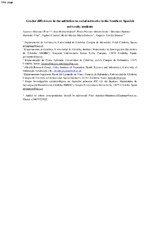Mostrar el registro sencillo del ítem
Gender differences in the addiction to social networks in the Southern Spanish university students
| dc.contributor.author | Aparicio Martínez, Pilar | |
| dc.contributor.author | Ruiz-Rubio, Manuel | |
| dc.contributor.author | Perea Moreno, Alberto Jesús | |
| dc.contributor.author | Martínez-Jiménez, Pilar | |
| dc.contributor.author | Pagliari, Claudia | |
| dc.contributor.author | Redel-Macías, María Dolores | |
| dc.contributor.author | Vaquero Abellán, Manuel | |
| dc.date.accessioned | 2024-01-12T11:15:54Z | |
| dc.date.available | 2024-01-12T11:15:54Z | |
| dc.date.issued | 2020 | |
| dc.identifier.uri | http://hdl.handle.net/10396/26521 | |
| dc.description.abstract | Social networks sites have become the most popular instrument used to communicate and exchange information resulting in the addiction to this media. Previous studies suggested that personal characters play an essential role in addictive behavior and gender difference may be involved. Nevertheless, there are contradictions about the influence of gender. Some studies indicated higher addiction in men. Meanwhile, other researchers pointed out higher addiction among Spanish teenage female. Little studies in the Spanish context have analyzed the different socio-cultural and biological factors possibly related to this addiction and gender differences. With all being said, this study focused on determining the current incidence of social networks addiction in young college students, relating this social networking addiction with loneliness, prenatal testosterone (2D:4D ratio), self-esteem and personal satisfaction. A cross-sectional study focused on female and male college students aged 17–25 years (N = 278) was carried out. It was used several surveys, including the Social Network Addiction Questionnaire (SNA) and the 2D:4D ratio. The results showed difference among male and female about addiction (chi-square = 12.77, p-value = 0.002). Moreover, this addiction was linked with several factors, such as importance given to social networks by females (p-value < 0.001) and males (p-value < 0.001). Also, the findings showed that addiction to social networks might be influenced by gender, showing more importance sociopsychological factors in females and a combination of biological and social factors in the men. Moreover, Instagram has increased as the predominant social network for communication for college students (97.2% men and 93.7% women). | es_ES |
| dc.format.mimetype | application/pdf | es_ES |
| dc.language.iso | eng | es_ES |
| dc.publisher | Elsevier | es_ES |
| dc.rights | https://creativecommons.org/licenses/by-nc-nd/4.0/ | es_ES |
| dc.source | Aparicio-Martínez, P., Ruiz-Rubio, M., Perea-Moreno, A., Martínez-Jiménez, P., Pagliari, C., Redel-Macías, M. D., & Vaquero-Abellán, M. (2020). Gender differences in the addiction to social networks in the southern Spanish university students. Telematics and Informatics, 46, 101304. https://doi.org/10.1016/j.tele.2019.101304 | es_ES |
| dc.subject | Addiction | es_ES |
| dc.subject | Social networks | es_ES |
| dc.subject | Gender differences | es_ES |
| dc.subject | Loneliness | es_ES |
| dc.subject | es_ES | |
| dc.title | Gender differences in the addiction to social networks in the Southern Spanish university students | es_ES |
| dc.type | info:eu-repo/semantics/article | es_ES |
| dc.relation.publisherversion | https://doi.org/10.1016/j.tele.2019.101304 | es_ES |
| dc.rights.accessRights | info:eu-repo/semantics/openAccess | es_ES |

